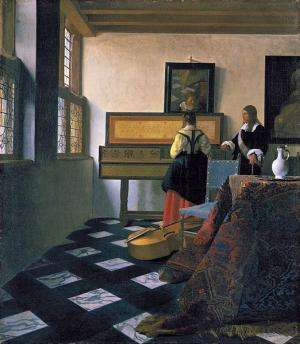December 3, 2013 weblog
Inventor creates replica of Vermeer painting using modified camera obscura

(Phys.org) —Inventor Tim Jenison may have finally solved the mystery of how famed Dutch painter Johannes Vermeer was able to create paintings that so closely resembled photographs. His five year mission to learn Vermeer's secrets has been filmed and a documentary made describing what he's learned.
Johannes Vermeer was a 17th century painter who stunned the world by suddenly appearing on the painting scene producing impressively realistic paintings, all seemingly without any training. Critics at the time suggested he "cheated" by using a device called a camera obscura, which is essentially a lens and mirror set up in a way to allow for better reference—it would be akin to painting using a photograph posted next to the canvas. The argument surfaced again in 2006 when modern painter David Hockney announced that the only way Vermeer could have painted the pictures he made, were by using some sort of mirror and lens contraption. The problem with the argument was that it couldn't explain how the lighting could have come out the way it did—a mirror/lens device would have produced an image that was upside down.
Shortly after Hockney's announcement, millionaire inventor Tim Jenison became intrigued by the argument. His background was in optics, so it seemed a natural way to pass his time investigating the possibilities. Instead of a hobby, however, it became more of an obsession. Jenison traveled to Amsterdam to see an example for himself. He claims that led to an epiphany—one so strong that he learned Dutch so he could read original texts. He learned about early paints and how to make mirrors and lenses himself. Eventually, he even faithfully recreated the room and sunlight conditions of where Vermeer sat while painting "The Music Lesson," one of his most famous pieces.
As time passed, Jenison became convinced he had an inkling of how Vermeer pulled off his trick—he'd added another mirror to his camera obscura, causing the image it created to become right side up. By positioning a lens and two mirrors just right, he found he could create what would look like a photograph, just next to the canvas, allowing for simple replication of an actual setting. Putting all that he'd learned together, Jenison created what he believes are the conditions Vermeer was working under. And to prove his point, he even created a stunning painting of his own—one that very closely resembles "The Music Lesson." He says, he's 90 percent sure he's solved the mystery. That last ten percent, he says, is there because he can't figure out how Vermeer managed to hide the knowledge of his improved camera obscura.
More information: via VanityFair
© 2013 Phys.org



















